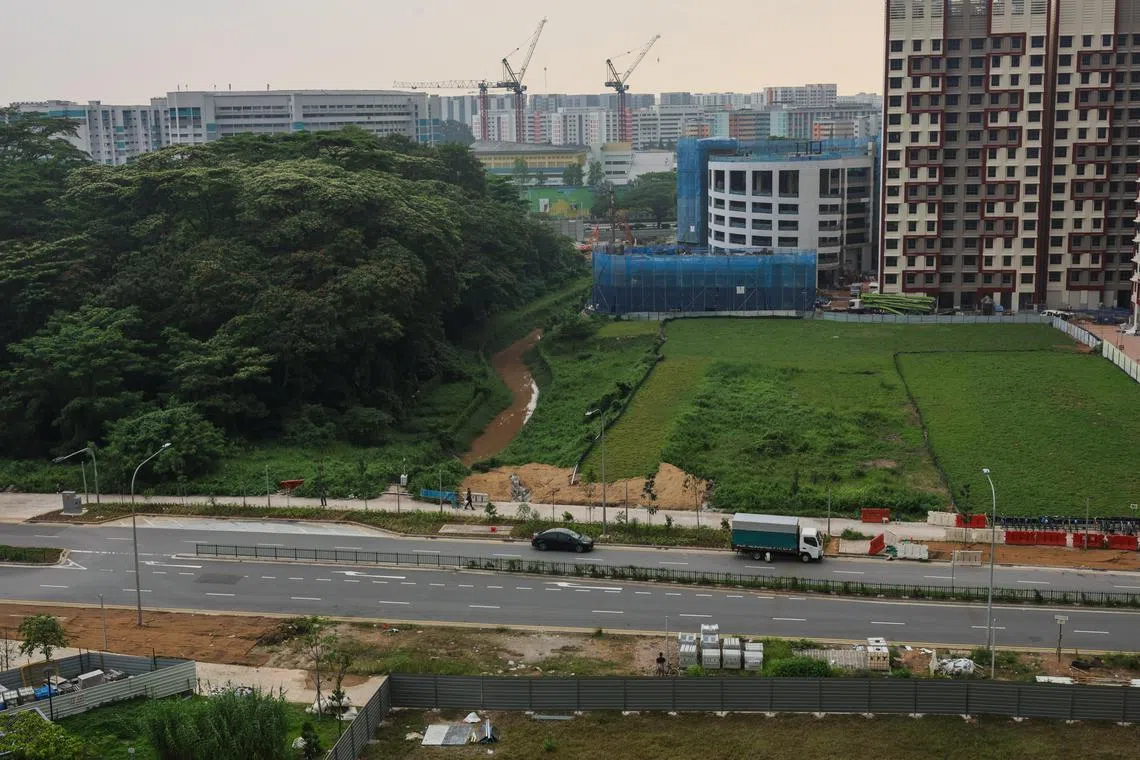Brown water in Tengah canal due to accumulated silt layers churned up by rain during monsoon surge
Sign up now: Get ST's newsletters delivered to your inbox

The silt has since made its way to Jurong Canal and likely even Jurong Lake.
ST PHOTO: GIN TAY
Follow topic:
SINGAPORE – The mud-brown water that had pooled in a temporary canal in Tengah Garden Avenue was caused by the accumulation of silt that had been churned up by the heavy rain during the recent monsoon surge, said PUB on March 31.
The silt has since made its way to Jurong Canal and likely even Jurong Lake, which is one of the 17 reservoirs in Singapore.
The national water agency said it has asked the contractors who are responsible for the discharge of the untreated silt to rectify the situation.
Nature Society Singapore (NSS) brought this matter to light in a March 22 post on its Facebook page, which included pictures of the brown-tinted silty water pooled at various construction sites within the up-and-coming Tengah estate and in the temporary canal.
When discharged into public drains, silty water – created by rainwater mixed with exposed earth materials and soil – increases the risk of flash floods when it rains heavily, because it reduces the fluidity of the waterways, said PUB in response to queries from The Straits Times.
It is also a concern for nature advocates because it impacts the ecosystem.
“The discoloured water limits the ability of stream-associated fauna – like kingfisher birds and otters – to forage for food,” said Mr Tony O’Dempsey, a council member of NSS.
Contractors are required to contain and treat silty water before it is discharged into public drains, in line with PUB’s code of practice on surface water drainage.
PUB was alerted to the silty water in Tengah by a member of NSS on March 21. This was after heavy rain drenched Singapore during a monsoon surge,
Checks by PUB officers found that a stretch of roadside tables along Tengah Garden Avenue was also not maintained properly, with exposed surfaces. This possibly contributed to the build-up of silt in the canal as well.
Roadside tables are designated areas on the road for other purposes, such as greenery or pavements. Since these tables are still a work in progress, the area currently consists of exposed soil and should be properly covered, according to PUB.
PUB said it is currently investigating the matter, although it did not say which agencies are involved in managing the roadside tables.
“PUB has followed up with the relevant agencies and their contractors to cover all exposed earth surfaces at the roadside tables along Tengah Garden Avenue and to carry out desilting work in the temporary canal.
“We will pursue enforcement actions if any of the contractors are found to be not compliant with earth control measure requirements,” said Mr Maurice Neo, director of PUB’s catchment and waterways department.

PUB said it has asked the contractors who are responsible for the discharge of the untreated silt to rectify the situation.
ST PHOTO: GIN TAY
Under the Sewerage and Drainage Act, offenders who fail to comply with regulations may face financial penalties and stop-work orders. They are also liable for prosecution and may be fined up to $50,000 and, for repeat offenders, up to $100,000.
In addition to containing and treating silty water before discharge, contractors on construction sites measuring 0.2ha or larger must install CCTV cameras to monitor the treated water that is discharged into public drains.
The visual feed from these cameras is analysed in real time, and if silty discharge is detected, automatic alerts will be sent to the project manager, earth control measures officer and other relevant parties.
Members of NSS suggested that many of the siltation cases might be a result of contractors failing to cover soil stockpiles before heavy rainfall, which causes soil movement to overwhelm site cut-out drains. This then leads to sediment overflowing into the surrounding area.
Aquatic fauna inhabiting forested streams adjacent to construction sites have been impacted in previous monsoon surges, Mr O’Dempsey said.
Forested streams are naturalised waterways running through forestation, with organic matter such as leaf litter and forest debris lining the stream bed.
These stream beds, which offer aquatic fauna habitats to seek refuge in, often get destroyed with siltation, the NSS council member added.
“This is a longer-term impact than the discolouration effect of the fine silts,” he said.
Mr O’Dempsey added: “There is a need to include rigorous and specific monitoring of construction site erosion control measures as part of the environmental management and monitoring plan, and failures need to have associated penalties.”
The public can report sightings of silty discharge in drains and canals to PUB’s 24-hour call centre on 1800-2255-782, together with details of the location as well as photos and videos.

